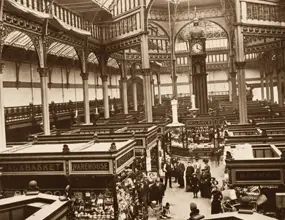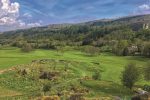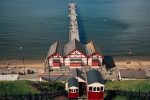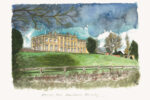The Story of Kirkgate Market Leeds – City Shopping Landmark
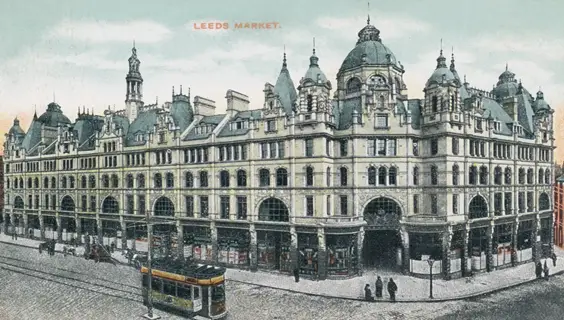
By Paul Chrystal
Leeds was always a market town trading one commodity or another. Defoe observed that the cloth market was a swift, early morning affair starting at 7am and all over by 9am when it was time for a good breakfast taken at public houses near the bridge.
These meals were called BrigEnd-Shots which, according to Ralph Thoresby, ‘the clothier may, together with his Pot of Ale, have a Noggin o’ Pottage, and a Trencher of either Boil’d or Roast Beef for two Pence’. At 9am the general traders set up and took over.
Thoresby again gives us the details as they were in 1715:
the market people of other professions, as Country Linen Drapers, Shoo-makers, hardware men, and the sellers of Wood Vessels, Wicker Basket, Wanded Chairs, Flakes [fences] etc.; the fruit sellers both wholesale and retail; the farmers selling dairy cattle; the fish traders; the butchers in the Shambles behind the Moot Hall; the egg, butter and poultry sellers; and the corn traders.
Up to 500 loads of apples might be sold in one day. There was a cattle market; the fish market was ‘furnished with a great variety of fish’. The butchers’ shambles remained on one side of the moot hall, with the wool market on the other. The poultry market was at the cross above the moot hall while above this was the corn market. There was also a horse fair in the Upper Headrow while the pig market was in the Lower Headrow, and the corn market was between the Market Cross and New Street.
“On the ground floor there were sixty stalls”
In other parts of the town, Thoresby concludes, there sold ‘whatever is necessary for the comfortable Sustenance of Mankind, though too tedious particularly to recite’. Leeds markets usually means Kirkgate Market but there were other market buildings, such as the Central Market and the South Market, established in the 1820s. Between 1600 and 1800 the cloth market moved from Briggate to the Cloth Halls although Briggate remained the site of the general market.
Briggate was by now a busy main road and quite an unsuitable place for a market. Something had to be done but the traders, shopkeepers and innkeepers could not agree on a site. Accordingly, between 1823 and 1829, no fewer than five different markets were built, including Kirkgate, which started life as an open-air market on Vicar’s Croft in 1822. Around 1875 Kirkgate became a covered market. Leeds New Market was built, catering for general produce and fish and a new fish market, an abattoir and a meat market were built later. In the early years of the twentieth century, the old covered market was demolished and replaced by the grand new market hall.
The Bazaar and Shambles, between Briggate and Vicar Lane, was established in 1825 by two well-named butchers, Frederick and Joseph Rinder. On the ground floor there were sixty stalls, fifty of which were butchers, arranged in two streets. On the first floor was the bazaar – a block of shops which was let to dealers for the sale of fancy goods, millinery and clothes. In 1858 part of the bazaar was used as a carpet warehouse.
“Badly damaged by fire in 1893”
The building was bought in 1898 by Leeds Corporation and demolished to make way for a new road. The South Market was built in Meadow Lane in 1824 as a general retail market. It comprised twenty-three butchers, twenty-six other shops, eighty-eight stalls, nine slaughter houses and eighteen houses. But the South Market failed and from 1827 only quarterly leather fairs were held there, and it became known as the leather market. The Central Market was a covered market in Duncan Street from 1827.
Most of the shops were butchers and fishmongers, although the covered central space had stalls for fruit, vegetables, and dairy produce. There was also a balcony where fancy goods were sold. In total it contained sixty-seven shops, fifty-six stalls, six offices and a hotel. As with South Market it was never a great success; Leeds Corporation bought it in 1868. The building was badly damaged by fire in 1893, and was knocked down with the extension of Vicar Lane into Duncan Street. A corn exchange was built at the top of Briggate in 1827. It had warehouses and offices for the use of corn factors, a hotel, an inn and four shops.
“Twice-yearly horse and cattle fairs”
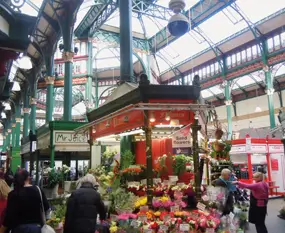
The 2015 photograph illustrates just how rewarding it is to look up at the roof now and again. The site of Marks & Spencer’s Penny Bazaar can also be seen
Despite it all, there was still no wholesale fruit and vegetable market or indeed a cattle market. An obvious site for another market was Vicar’s Croft. The cow and pig market had already moved there in 1822, along with the fish market and the wholesale fruit and vegetable market. Kirkgate Market, as it was called, was a great success, but since no tolls were paid, there was no money to pay for the upkeep of the market or to clear the rubbish and filth that piled up.
From 1830, tolls were exacted and improvements were made. Soon there was a need for a larger market. The council bought the adjacent land and the market extension was completed in 1846, housing the cattle market and the fruit and vegetable market. In 1855 the cattle market moved to between North Street and Camp Road, where twice-yearly horse and cattle fairs were also held.
Weather was a major problem: the market was duly covered over and opened in May 1857 à la Crystal Palace: The Leeds Guide of 1858 gives us the details:
The building is of iron and glass, covering an area of 4,040 yards and is situate at the junction of Vicar Lane and Kirkgate. The style of architecture is Gothic. It has 44 convenient shops on the outside, and thirty-five inside, where there are also four rows of iron stalls. At night this beautiful crystal market hall is well illuminated by 200 gaslights, arranged round handsome cast-iron pillars. Altogether it is the most complete structure of its kind in England.
“Marks & Spencer opened a stall in the market”
It sold everything from ‘Poultry to Potatoes; Books to Nuts; Images to Mercery, and Bacon to Beans.’ Dogs, hawkers, smoking, and swearing were banned. Kirkgate Market was expanded again in 1875, and Leeds New Market was built. A new covered pig market for up to 1,500 pigs was built, with space for a hay and straw market. At the New Market the fish market was in a square with its cleaning central fountain. There were five rows of retail fruit and vegetable shops and the Game and the egg and butter market and an area where dogs and birds were sold.
In 1884, Marks of Marks & Spencer opened a stall in the market: their original penny bazaar. Michael Marks was an immigrant Lithuanian Jew who began trading with a penny bazaar store where everything cost a penny: the nineteenth-century equivalent of today’s pound shop. He later moved to Wigan where he teamed up with Tom Spencer of Skipton to form what was to become one of the most enduring and successful British retailing companies.
Kirkgate Market is still one of the largest in Europe with some 800 stalls and 100,000 people visiting the market on Saturdays, attracting shoppers from as far away as Newcastle, Hull and Sheffield.
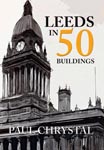
 Extract from the book ‘Leeds in 50 Buildings’, courtesy of Paul Chrystal
Extract from the book ‘Leeds in 50 Buildings’, courtesy of Paul Chrystal
Available from Amberley Publishing: amberley-books
